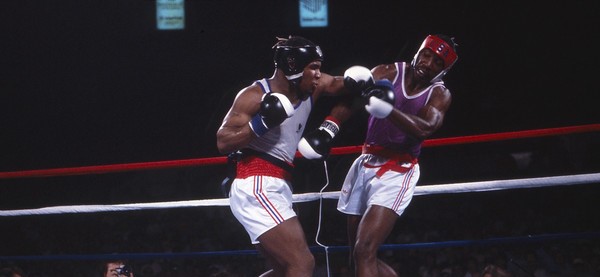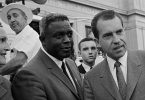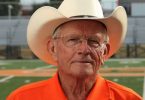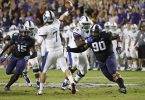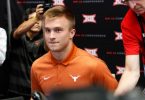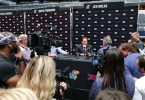FORT WORTH — The NCAA Women’s Gymnastics Championships began Friday at the Fort Worth Convention Center, likely one of the last sporting events the venerable arena will host before its planned demise.
City staff is working on a proposed expansion of convention space that will include a wrecking ball for the 50-year-old domed coliseum, which to gawkers passing by has more resembled something out of the Jetson’s on the downtown landscape since its opening in 1968.
The new Dickies Arena, which will open in the fall, has put the obsolete Convention Center arena on the list of do-not-resuscitate.
The Convention Center arena has served its purpose as a gathering place for the cultural arts.
Elvis tossed scarves to the salivating cult there. Mick Jagger gyrated with the Rolling Stones. Led Zeppelin rocked and rolled. U2 dazzled Gen X. Garth Brooks charmed. And Willie Nelson smoked, no doubt.

Before Reunion Arena opened, the Convention Center got all the big shows.
To wit, Paul McCartney’s show with Wings at the Convention Center arena in 1976 was his first in America in 10 years. The “Wings over America” North American tour kicked off not in New York, Chicago, Los Angeles or San Francisco, but in Fort Worth, Texas.
Take that, Yoko.
The April show was the first of 31 dates in 20 cities. A ticket could be had at the box office for as little as $7.50 or $33.50 today. That’s a bargain for a Beatle.
On the eve of the Super Bowl in 2011, real and football cowboy Walt Garrison, who might have been galvanized by the spirit, if you know what I mean (it’s hard to tell with him), had one of the best one-liners since the days of Hell’s Half Acre:
“The big difference between Fort Worth and our friends from the east is in Fort Worth the bullshit is on the outside of the boot.”
The sporting arts have also taken center stage here.
“We’re going to make this Convention Center host to as many sports events as we possibly can,” said Tarrant County Judge Howard Green, the chief political officer over the then-Tarrant County Convention Center, in 1968. The city bought the complex from Tarrant County in the late 1990s.
“We’re really excited about this facility for basketball.” Green said. “It’s conceivable we may eventually have eight teams involved in the Texas Classic.”
That first Texas Classic in 1969 involved Cotton Fitzsimmons’ Kansas State Wildcats, Henry Iba’s Oklahoma State Cowboys, and TCU and UT Arlington in a round-robin format. At the time, the 12,500 seats for basketball represented the largest facility in the state for college basketball.
TCU would return there over the years, the last time under Billy Tubbs in the 1990s.
The ABA appeared at the Convention Center in December 1969, the Dallas Chaparrals and Miami alternating possessions of the league’s distinctive red, white and blue basketball. In their first 10 years or so, the NBA’s Dallas Mavericks, too, played a preseason exhibition game each year at the Convention Center. It was outreach to the team’s fans on the west side of the turnpike.
The Southwest Conference indoor track and field championships called the convention center home for years.
Some of the events have long been forgotten. Consider the national debut of a full-contact team karate league in 1975.
The commissioner: Chuck Norris.
“This isn’t hoked up and nothing is rigged in advance,” like pro wrestling, said the mythic hand-to-hand combatant. “These fighters are out to knock out their opponents because there is money at stake.”
To the winning team went $4,500. To the losers, $1,500.
I would say I need more to get my head kicked in, but then I write for a living.
The Convention Center has been home to some very significant events as well over her six decades.
“Have you ever been to Brownsville, N.Y.?” the young boxer said at 1984 U.S. Olympic Boxing Trials at the Convention Center. “Life in Brownsville [part of Brooklyn] is far removed than anything you can imagine. The world there is much different than yours.”
His name was Michael Tyson, an 18-year-old who would gain both fame and infamy in the years that followed as Mike Tyson.
That June, we learned the whole story and about all the affiliated characters. As Mike Tyson’s world turns was a big wild card.
It was the guiding influence of Constantine “Cus” D’Amato, Floyd Patterson’s one-time trainer, who changed the young boxer in and out of the ring. The other guy in the ring was Kevin Rooney, the brash, in-your-face New Yorker.
“I met him through a friend of mine – when I was still getting in trouble in the streets,” young Mike said. “I credit D’Amato with improving me as a person as much as making me a better boxer.”
He was as cocksure then as he was a little more than a year later when he won his first heavyweight world title. “I have more belief in myself than anyone on the planet. I give myself reason to be confident.”
And he refused to go into the ring first. That was reserved for the champion, and he was the champion, sort of … the national Golden Gloves champion. As a result, “I go in the ring last.”
Tyson advanced to the final to meet Henry Tillman, essentially for a berth in the Los Angeles Games in 1984.
In typical Tyson form, the future undisputed heavyweight champion knocked Tillman down in the first round. However, Tillman settled the fight down, refusing to be goaded into a slugging match. Tyson did Tyson things, charging, lunging, hooking and banging, but he was unable to knock down Tillman again and unable to make a convincing case for the judges.
Tillman earned a unanimous decision victory, winning over all five of the judges. Afterward, Tyson went in for a drug test. He exited, saying his passed test was the first good news all day.
D’Amato raged.
“Everybody is gonna hear about this,” said D’Amato, who was making sure of it as he yelled at ringside judges, in particular Bob Surkein, marked as the prime villain in this alleged box-lifting. “There’s more scandal in this outfit than there ever was in the pro game.”
Cus flailed a towel to add emphasis to his charge.
Rooney: “What happened to us here was political. They told us we’d have to win it the hard way.”
D’Amato: “That’s right! One of the judges told me that. Told me that on the phone.”
Rooney: “They don’t want us around. We have pro fighters. I’m a pro fighter. They don’t want pros mixed in with the amateurs. They want us out.”
Rooney said he and D’Amato had asked that Surkein, who been a boxing official since 1943, not participate in the judging but, “They let him judge it anyway.” The executive director of the Amateur Boxing Federation, Jim Fox, said he was unaware of any request.
But in an interview earlier in the week, Surkein had sized up Tyson as a “strong kid, who has been taught all the pro rules. No question he can bang. Whether he has overcome those stinking pro tactics Cus has taught him, we don’t know.”
Hmmmm.
Tyson lost to Tillman again in an Olympic Trials box-off in Las Vegas the next month, but he got even as a pro six years later. He knocked Tillman out in the first round.
Those Trials in Fort Worth produced an American team in Los Angeles that many consider the greatest U.S. Olympic team ever. It included Pernell Whitaker, Mark Breland, Virgil Hill, Tyrell Biggs and Evander Holyfield, another of Tyson’s future nemeses.

In 1992, the U.S. won a 30th Davis Cup tennis title at the Convention Center. The team of Andre Agassi and Jim Courier in singles matches, and Pete Sampras and John McEnroe competing in doubles defeated the peaceful Swiss, who never would’ve allowed Cus D’Amato to cross the border.
Courier’s victory over Jakob Hlasek clinched it.
And, yes, there previously has been world-class gymnastics.
Downtown this weekend is dotted with the symbols of a college spirit shop.
In 1979, it looked to be the United Nations as the countries of the world descended on Fort Worth for the World Gymnastics Championships. Among them was the sport’s darling, Nadia Comaneci of Romania and coach Béla Károlyi.
A hand injury limited Comaneci and, in fact, necessitated a visit to Baylor All Saints hospital.
The event turned out to be a coming out of sorts for the U.S. men, who achieved the unthinkable, a team bronze.
The U.S. finish was a bellwether, said coach Roger Counsil, who watched his team cap a decade-long hunt for respectability.
“It was what we have been striving to get since 1970,” said Frank Bare, U.S. Gymnastics Federation executive director. “We finally had a full-time organization to promote the sport, and we’re in the company we want to be in.”
Kurt Thomas, the 1979 NCAA champion who finished second to Alexandre Ditiatin of the USSR in the all-around, won six medals, including gold on high bar and floor, and silver in all-around, parallel bars, and pommeled horse. Bart Conner of Oklahoma won gold in the parallel bars and added a bronze on vault.
After years of trying, the Soviets won team gold, finally edging the Japanese. The coach sounded like a propaganda minister.

“The scores received by our gymnasts truly mirror the power and ability of our gymnasts,” said Leonid Arkaev as if Stalin himself, bottle of vodka in hand, were levitating nearby. “If you remember our previous meets with Japan at the Olympics and Montreal and at Strasbourg, the victory does not come as a particular surprise to us.”
We had good reasons to point missiles at those guys.
By then, we were better friends with the other of the Marx Bros., the Red Chinese, even if the town of Ripley Arnold was a mismatch in some ways culturally.
Chinese visitors were spotted using plastic coffee stirrers as chopsticks to enjoy a Texican specialty, nachos.
(Lead art: ABC archives)

